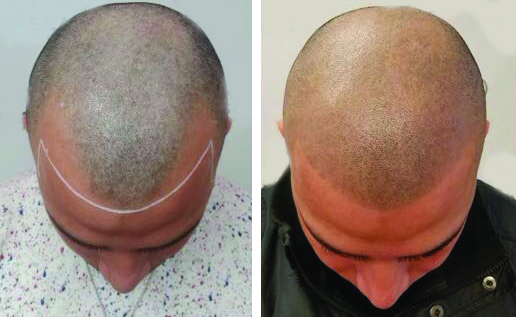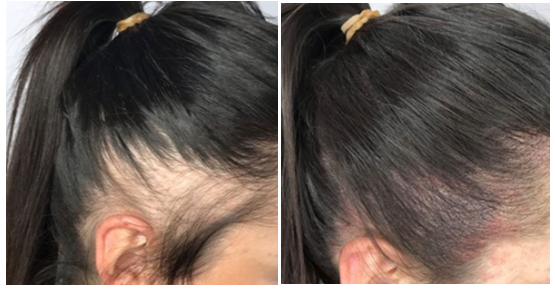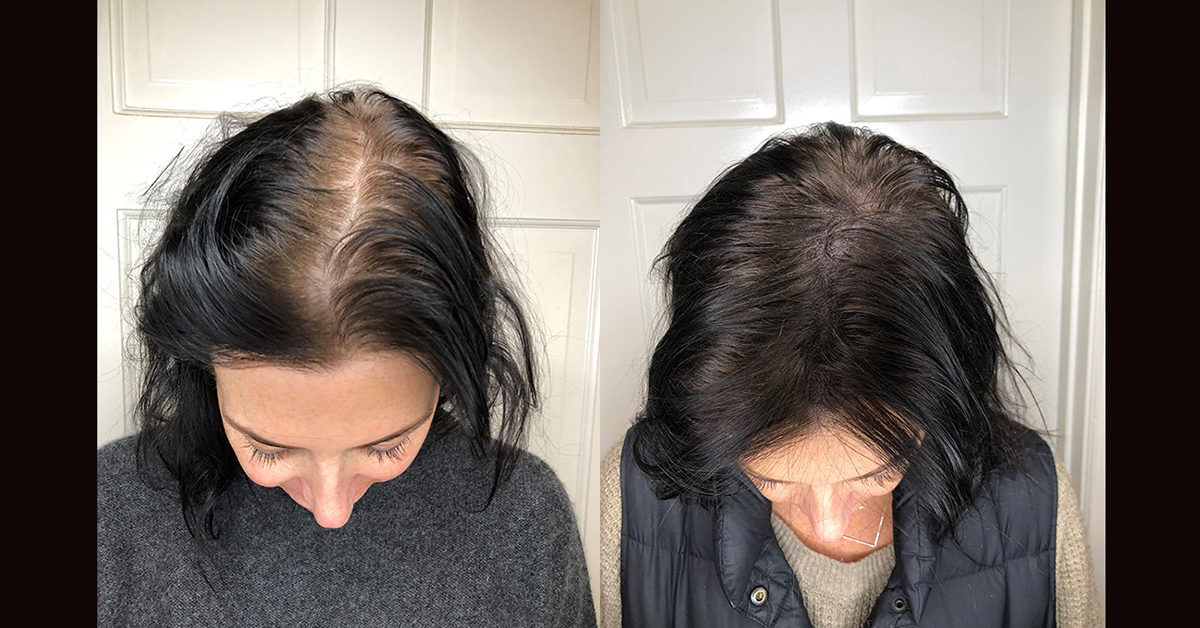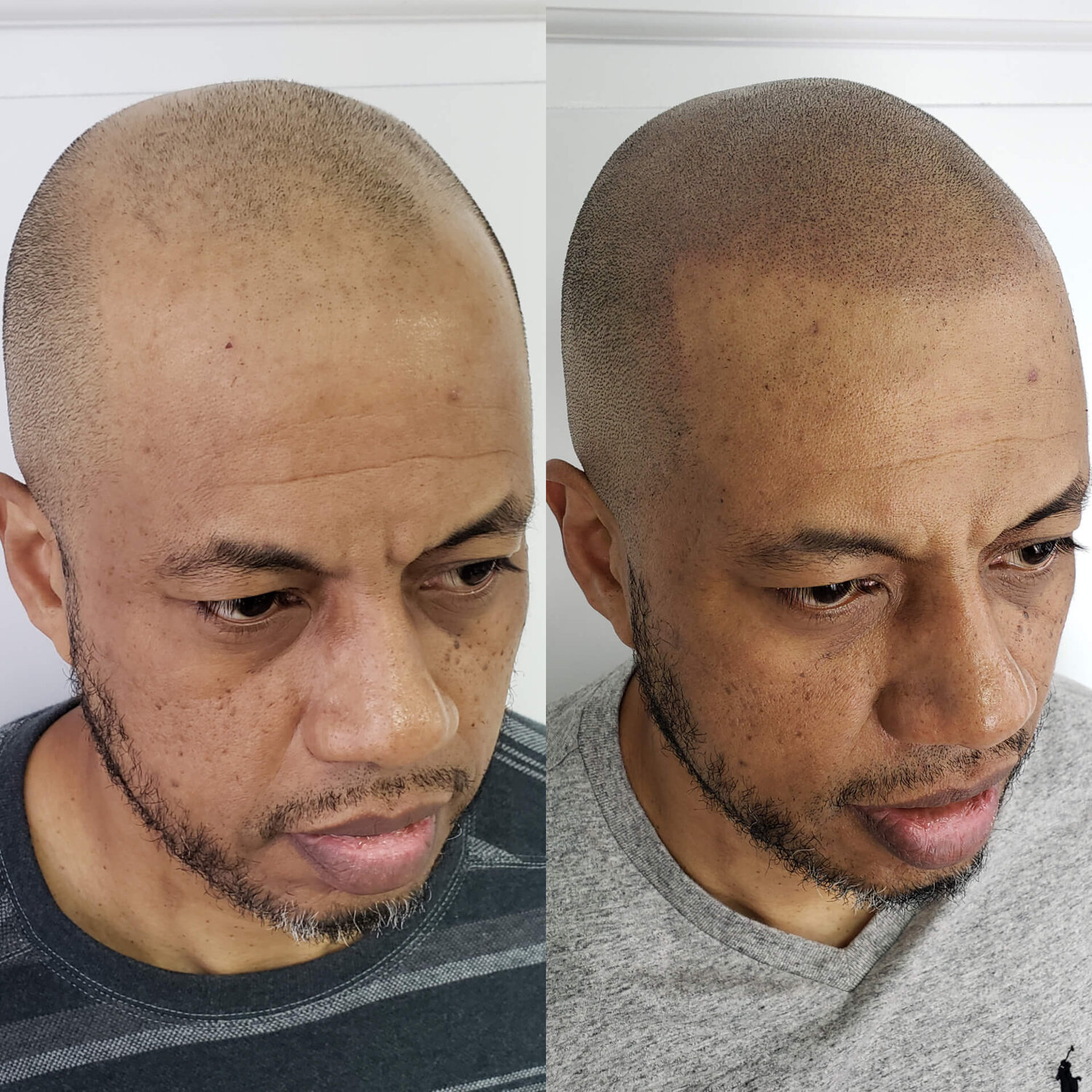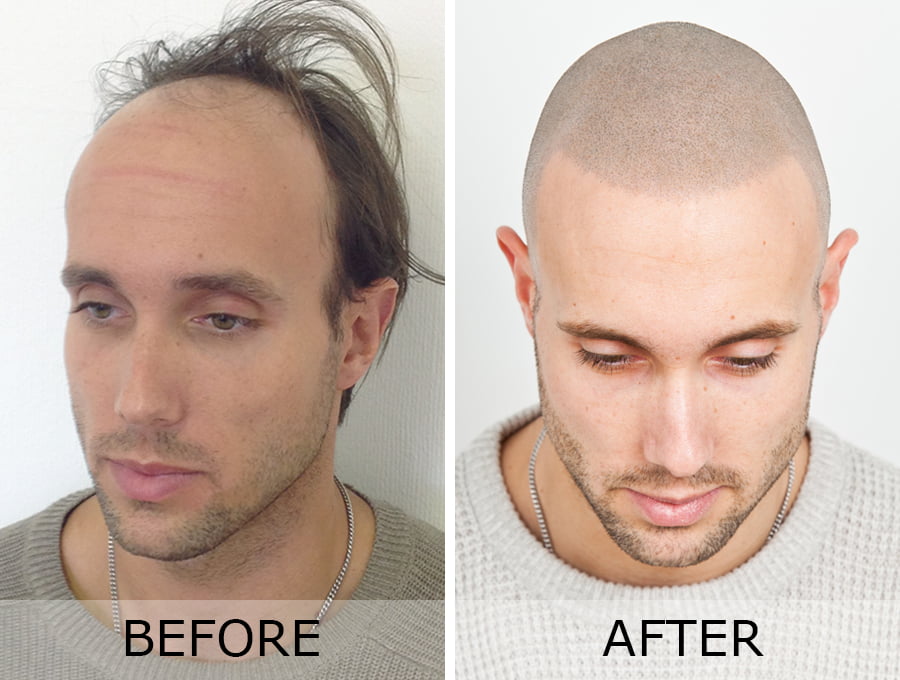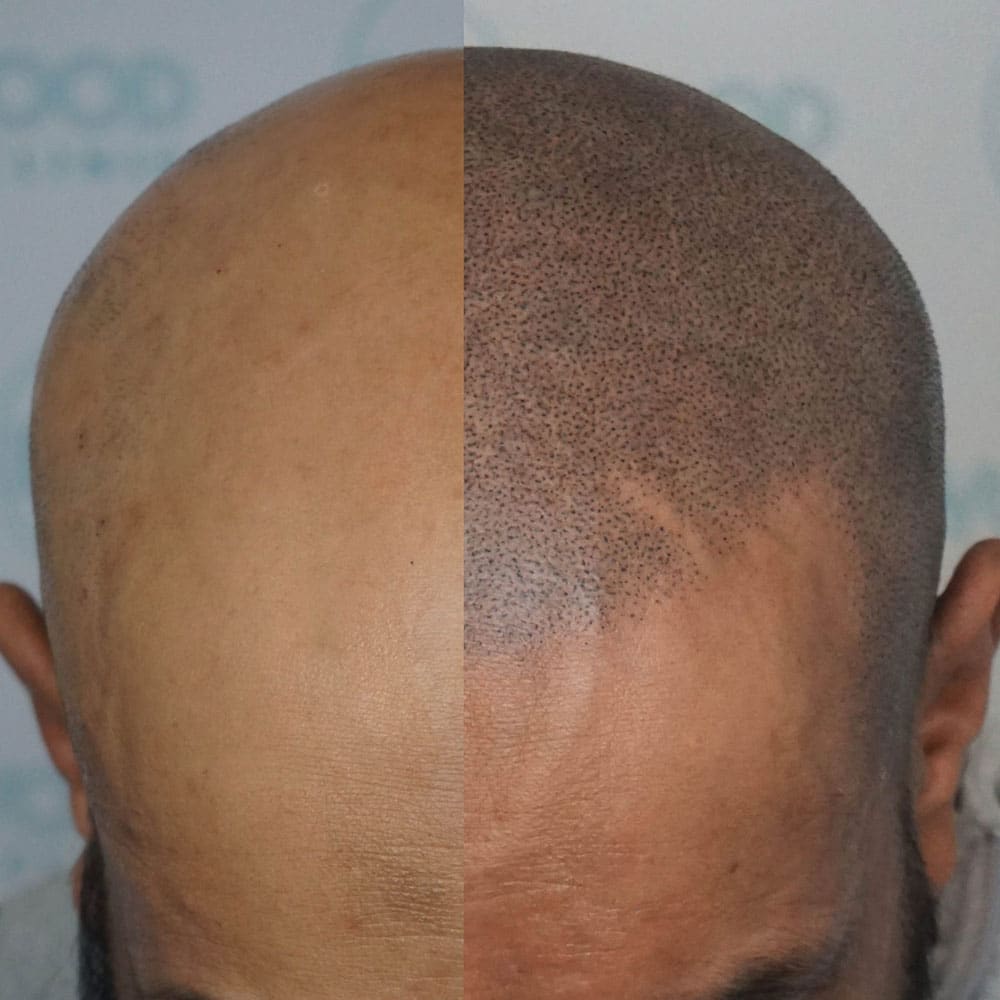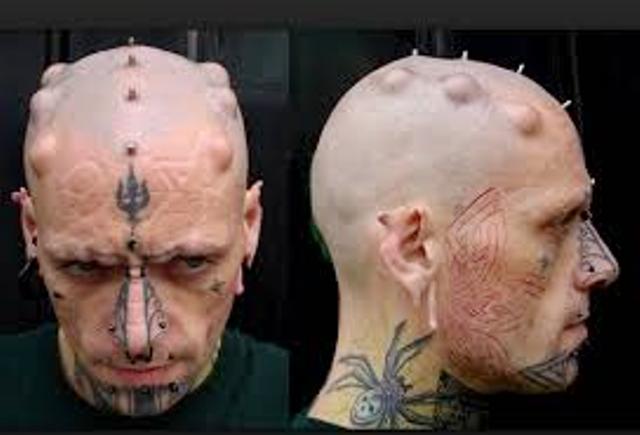The method of scalp micropigmentation (also perceived as SMP), spreads beyond just tattooing your hair. It’s a widespread form of non-surgical hair loss treatment that consolidates natural pigments into the dermal covering of the scalp to give it a barbered head look. Consequently, it’s an excellent choice for people undergoing hair loss.
It intensifies the shape of eyebrows, lips, eyes, and more with micropigmentation, which is a successful ornamental procedure both for men and women. With smudge-free applications for hair loss, the self-confidence and self-esteem of those with alopecia or hair loss can be reestablished to help restore confidence and self-esteem.
Hair loss can be handled in various ways, with a series of options available to those in necessity. As the technology and attention behind dealing with baldness stretch to develop and improve, men and women can undergo hair transplantations and advanced hair systems.
In contemporary years, scalp micropigmentation has become a more popular therapy for those who have lost their hair or a full head. But what does it require? For a thorough overview of this latest treatment, Optima Hair demonstrates the micropigmentation process hereinafter.
The Basics of Scalp Micropigmentation
Contents (Click to Jump)
Understanding Scalp Micropigmentation is most manageable if you think of it as a manner of scalp tattoo. The scalp’s epidermal layer is employed with a natural pigment in this non-surgical procedure, which replicates the occurrence of natural hair follicles. Practitioners strive to conceal the spaces of the scalp where hair loss has happened, thereby generating a new hairline for the client.
You may be accustomed to the method of microblading eyebrows, which is very alike. Microblading is performed with a manual blade, while scalp micropigmentation must be completed with an electric tattoo apparatus. Exercising care of the scalp needs a lot more strength than dispensing with the skin beneath your eyebrows, which is a lot more concentrated.
Further benefits of the Procedure
Additionally to supporting a client’s self-confidence, the SMP procedure also contributes a way for injuries from past surgeries to be coated. A client who has earlier had a hair transplant method that may have generated a few complexities may be able to benefit from SMP to help cover any scarring or shortcomings.
Who is Scalp Micropigmentation for?
Anyone experiencing any class of hair loss should recognize the procedure. This involves people with:
- Alopecia areata
- Thinning hair
- Male and female pattern baldness
How long does this treatment take?
A Norwood Scale is a grading practice that can be handled to determine the degree of male pattern baldness. The method starts with a hair loss estimation that includes future prophecies for hair loss. There must be at least five days between individual deliberations. It is standard to see a slight splotch on the scalp as it occurs to heal. The purpose for this is entirely related to the natural treatment process of paring and regeneration. The pigment becomes more noticeable and more precise from session to session.
What to expect during the Scalp Micro-pigmentation session?
Before you commence your first treatment, the team will ask you to take a photo of your head so they can see the disparity between your original look and your ultimate appearance. Moreover, they present you with a detailed survey of the hair tattooing procedure along with images from their preceding clients.
A hairstyle of your selection. Depending on the sort of hairline, some men will gratify a sharper hairline while others will favor a more discolored or scattered one. Consult with your hairstylist to ascertain your best possibility. Choosing the accurate ink and shade that harmonizes your skin tone and eyebrows is the following step after determining a design. The best choice is to choose the tattoo ink tone that coordinates your skin tone from a wide diversity of tattoo ink colors. Get tutored about the treatments and pause to see what the consequences are.
As a component of the first hair tattoo treatment, the practitioner will identify the areas that will be supplied. Your doctor can set a baseline consistency for your appearance that will frequently be quite scattered in the future during this first appointment. You want to make certain that the effect is nice and even without any heavy pigment flaws. Your skin will need time to recuperate before the second session. Furthermore, some areas of the scalp may be more susceptible than others, although moderate pain will be more bearable.
However, some subjects prefer the third hair tattoo procedure to get a more concentrated hair look. The second hair tattoo treatment may be more powerful and darker, but the third treatment process may be less intense and more inadequate. A thinning hairline or receding hairline can be saturated with a result that solidifies both. The treatment entails a small tattoo machine with one or more small needles (also understood as micro-needles), which are assigned to the epidermal layer of the head, and a pen is practiced to carefully follow each point on the shaved area following the hair.
How Do You Prepare for the Procedure?
Before your operation, you will be given guidance to follow by your practitioner. It is ordinarily OK to shave or pluck your hair within 48 hours of accepting the treatment. Some strategies do not need shaving or plucking.
It is essential to cook a meal before undergoing a procedure. A snack and a drink may also be delivered with you. When you feel apprehensive, ask your buddies or family to observe a movie or listen to music to occupy you.
The Procedure of Scalp Micropigmentation
Three to four sittings are usually expected to complete treatment. Let’s escort you through the method step-by-step:
- The first step is to inquire about a quote from our crew. By forwarding us photos of your uncommon hair loss over text or email, or by video chat through Zoom, FaceTime, Hangouts, etc., we can efficiently assess your unique volume of hair loss. We will uncover more about what effects you want to obtain from your treatment during this process. You will be supervised through the process by our specialists and be able to determine the right style for your requirements. Then we devise a plan of action, explaining what you need to do to accomplish your goal and realize the outcomes you desire.
- Following that, the processing begins. Our years of experience have instructed us that it is most helpful to be traditional with your first treatment to produce the best result. The objective of this session is to lay the framework for the alteration to come. In a single day, your scalp will be red after your initial treatment but should recover to normal within a few days.
- As a component of your second treatment, we will append more detail and blacken your skin tone lighter. A session like this is where your treatment takes configuration, and your new look becomes concluded. During this session, we will discuss any anxieties, questions, or inquiries you may have.
- There may be a third procedure at times, but it’s not always important. Third treatment sessions are typically finished 4-12 weeks after the first sessions and are usually performed at the behest of the client to either go more shaded or to “touch up” spots that may have consistently lightened through healing. If you are owning trouble settling your look, our practitioners may tell you that you will require 3 sessions. In these instances, the client may have a blemish being covered up, be experiencing alopecia, wanting to improve their hair transplant, or have degraded or oily skin. Additionally, neglecting to follow the aftercare directions may increase the probability of wanting a third session.
When we extract a job, we will talk to you about the particular results you want to accomplish so that a custom procedure can give you the results you yearn for. Using skill and correctness, we mix our pigment carefully with the color of your tangible hair when embedding our ink. The procedure is remarkably comfortable, and numerous people report an instantaneous increase in self-confidence following one sitting.
SMP Styles and Hairline Options
Various opportunities and styles are possible. Below, we have described a few of the most prevalent:
The Permanent Edge Up
There is a modern choice known as the “Jamie Foxx”, also called the “Edge Up”. For this appropriate procedure, it is very necessary to commence conservatively with the hairline. To begin designing the hairline and side temple area first, an exceptional deal of evolution is needed. We intend to produce a full head of hair with a sharp hairline, while also generating a robust and youthful edge-up by equaling the different colors and thicknesses thoroughly during these procedures. We produce edge-up styles that are regularly sought after by stardom at Hairline Ink.
Soft Hairline and Widowed Peak
It is typical for people to crave to lower their current hairline, enhance volume in areas where it has lessened, and develop to have more hair and a more constant hairline. Using layers of patterns, we mimic the impression of natural hair, giving the pragmatic appearance of hair with no stubborn lines. We must match the ink color specifically to the client’s hair color, which follows in an astonishingly natural-looking tattoo.
Adding Density to Thinning Hair
For gentlemen and women of all ages, Scalp Micropigmentation is the precise solution to cover or fill in weakening hair. In some circumstances, thinning can produce about an undesired, broad area of the scalp showing over the hair. A person with hair loss will commonly have an even coverage beyond the scalp, but the quantity drops as the loss advances. In addition to reestablishing lost hair density, scalp micropigmentation produces the delusion of a fuller, more uniform head of hair.
In this focused and specific manner, we manage the front hairline and combine it into your present density in a physical way. The initial treatment boosts densities throughout the balance of the hair thinning area smoothly and softly. Using various shades of pigment throughout various sessions, we also generate a three-dimensional effect, allowing us to give the impression of a natural umbra. Adopting this technique is an outstanding alternative for people who have had hair transplants but did not get the consistency they fancied.
Covering Up Hair Restoration Surgery Scars
In case you have encountered a hair transplant, you may have been left with marks. As many as FIFTY hair transplants have been conducted on some of our consumers!
Due to the insufficient amount of donor’s hair feasible, we assume hair transplants are usually less efficient than Scalp Micropigmentation. Shortage of enough donor’s hair deters many people from even suiting for hair restoration operations.
People typically endure drastic scarring, twist holes on their heads, and a resulting feeling of uncertainty after undergoing FUE or strip scar surgery.
In many instances, people are left with two opportunities: They can have various hair restoration procedures that devise scars and cost even more bills, or they can choose for Scalp Micropigmentation, which provides an instantaneous, permanent effect that discharges regular hair transplant techniques while concealing scars from preceding procedures.
That appears like a pretty honest decision, doesn’t it?
Our procedure at Hairline Ink doesn’t just camouflage the scars, but it also gives the impression of a fuller head of hair by combining frequency where the hair restoration has not been efficient, giving you the insight of courage you were soliciting when you underwent your first hair reconstruction.
Due to its capacity to conceal operational flaws as well as to hide failed hair transplants, scalp micropigmentation is the absolute solution for screening scars of all kinds: FUT strip scars, FUE (Follicular Unit Extraction) scars, scalp reduction scars, and Historic Plug or Cobblestone marks from old-fashioned hair restoration procedures.
It is conceivable to cover up scars in two distinct ways:
- Holding your hair long will allow us to conceal the scar underneath the hair.
- Alternatively, you can barber your hair short to mingle it into your follicles and disguise your scars altogether. The prescribed alternative takes between two and three sittings for optimal outcomes.
Redness happens immediately after therapy. Depending on the skin’s energy, it may persist anywhere from 30 minutes to eight hours.
Hair transplant methods can be made more thick-skulled by computing density
In extension to hair transplants, many hair replacement professionals suggest Hairline Ink to their customers. As a component of a pre-planned alliance, scalp micropigmentation can be applied in compound with hair transplantation.
When blended with traditional hair reconstruction and Hairline Ink’s extremely advanced technique, the patient has two elements in their support: authentic, textured hair with the presence of thickness and fullness that can only be accomplished with Scalp Micropigmentation – a truly innovative outcome.
The unit at Hair Transplant HQ will review with you during the announcing stage which degree of Scalp Micropigmentation should be implemented. The hair transplant procedure should be conducted in the majority of cases. In some illustrations, Scalp Micropigmentation may require to take place before the therapeutic procedures. The most trustworthy way to find out whether Hairline Ink is correct for you is to give us a visit. Our team is keen to answer your queries.
Scalp Micropigmentation Treatments for Women
Thinning hair and hair loss are prevalent dilemmas among women. An extraordinary 40% of balding Americans are women, even though the largest people correlate hair loss with male pattern baldness.
The purpose of Hairline Ink is to generate the impression of a natural, full head of hair by producing an underlying impact. When you can see the scalp, we comprise it up to hold it looking youthful and full.
People who have thin, thinning hair on their head’s tip or in the crown are perfect candidates for scalp micropigmentation. Our unit has operated with and administered many female patients with alopecia and surgery marks.
Care Instructions to Follow After a Treatment?
You will obtain directions on how to care for your medication after each one. Below are the most prevalent types of post-treatment precaution.
In the first four days following a surgery concourse, you should:
- Touching the administered area is not approved
- It is most suitable to avoid showering so the water won’t knock your treated zone
- The treated area should not be stripped for at least ten days
- You should desist activities that cause you to perspire extremely
- Keep away from straight sunlight
- Do not go swimming because the domain will be absorbed with water
- You should bypass hot tubs, steam rooms, and saunas because they induce you to sweat
- It is also expedient not to use moisturizers or shampoos on the administered area.
- It should remain clear and dry as much as practicable.
You can wash your head tenderly with mild soap and cold water starting on the fifth day after your sitting. Your scalp should be moisturized three times a day with non-perfumed merchandise. Doing so will prevent your skin from becoming excessively dehydrated and flaky.
Additionally, it is imperative not to let your hair grow too lengthy. This will produce the impression of patches and thinning. You should employ an electric shaver instead of a hand-operated razor. During the first 10 days after the procedure, do not use a razor blade to moist shave.
What Should I Expect After the Procedure?
The bulk of clients have limited to no problems following treatment. Redness and slight inflammation are normal side effects according to the Journal of Cutaneous and Aesthetic Surgery. They should pass away within a few days.
Swelling, redness, and pain could mean contamination if the area becomes more swollen, red, and painful. You may feel flushed if you have an infection. Discuss with your practitioner or professional as soon as reasonable if you encounter any of these manifestations.
What Are the Possible Side Effects of Scalp Micropigmentation?
Redness and itching are the most obvious side effects of scalp micropigmentation. It regularly goes away after a few days as the skin on the scalp recovers. Customers may experience some more serious side effects in limited situations.
Some of these “side effects” are generated by the inappropriate technique of operating challenging skin types.
Swollen Lymph Nodes
Penetrating unnatural cells from the blood is done by the lymph nodes. If they become engorged with cells assumed dangerous by the body, lymph nodes become augmented.
A swollen lymph node appears like a firm ball that can be rolled around. The lymph nodes tapping the scalp are positioned behind the ears, behind the bottom of the skull, and adjacent to the neck. They might not feel discomfort when touched.
A swollen lymph node is usually a sign of contagion. However, seldom do they inflate due to pigments utilized.
Scalp Tightness
Customers sometimes lament about their scalp feeling cramping. During the restorative process, miniature scabs form which are less stretchy than normal skin. In the method of healing and discarding the scabs, these bruises feel more natural and relaxed.
Oversized dots
In the days following micropigmentation, crusts form on each spot. These scabs will comprise pigment. When this appears, the dots seem larger.
The scabs drop off after about five to ten days and the accurate size of the dot becomes obvious. The hair follicle will seem like a normal one once it has recovered entirely.
Quick Fading of the Pigmentation
Victims sometimes inadvisedly believe that fading pigmentation is the outcome of scab healing. Their condition may deviate from what they anticipated. Talk with your practitioner or specialist if you are encountering this.
Dots Changing to a Blue Color
It may replace color if the practitioner or artist uses conventional tattoo ink and infuses it too deeply into the skin. When the pigments are submerged under the skin, they split down and turn blue. Tools that become contaminated can also happen in this.
You should communicate with your physician if you see any signs of infection, including swollen lymph nodes. Moreover, you must operate with an extremely qualified practitioner or artist.
Long-Term Care
The subsequent long-term care tactics will help you circumvent obstacles in the future. Sunblock with an SPF of at least 30 should always be practiced whenever you’re outdoor.
If you perspire or get wet while you’re out, reapply the sunscreen. If the attended area is bared to sunlight, the pigment may disappear more promptly.
Sustaining healthy skin on your scalp can be accomplished by employing body lotion constantly. For the first 28 days after treatment, you should avoid swimming in chlorinated pools. Paying close attentiveness to safeguard measures will lengthen the life of your medication.
Is Scalp Micropigmentation Permanent?
No, this question cannot be responded to. Our skin develops and discards the outer layer as we mature. Accordingly, pigmented follicles will dissolve over time. With peculiar care, most medications can persist between five and six years.
Does the process hurt?
To make the method as convenient as practicable, your SMP practitioner applies numbing means to the scalp before the procedure starts. You may however feel some distress during the procedure. The volume of discomfort you feel is defined by your susceptibility to pain.
At your introductory consultation, our trained technicians will help you settle for the procedure and let you know what you necessitate to do before the time of the procedure.
During and after your final operation, you may be asked to practice the following precautions:
- Swimming not permitted
- For 28 days after your last procedure, do not practice saunas or steam rooms
- Exercise should be withdrawn for five days following the latest treatment
After the fourth day of your last medication, you should also start moisturizing your scalp (something you’ll require to do between treatments).
When would I see results?
Although the consequences of hair pigmentation are detectable immediately, you will require to schedule several sittings/treatments with a practitioner after your introductory consultation to obtain the optimal results. Each session is taken out within a hygienic, comfortable environment, which assures the patient’s convenience and the most eminent quality of results.
Scalp Micropigmentation Removal Techniques
As we discussed at the outset, you have three processing options to decide from for the extraction of a scalp micropigmentation treatment: laser removal, saline removal, and UNDO.
1. Laser Removal
Tattoo removal with lasers comprises perforating the skin with high-energy lasers. Applying this method forever damages the pigments of the ink that are used by the epidermal device to administer color to the cells. Fading micropigmentation is an element of talent, and the procedure can exercise anywhere between three and ten sessions, depending on numerous determinants.
2. UNDO Scalp Micropigmentation Removal
The unique process came from Candice Piroli and Seif Sidky, the pioneers of scalp micropigmentation of Estetique International. Because the procedure does not utilize saline or lasers, it is the favored method for SMP practitioners to eliminate themselves.
Correlated to the other options, UNDO has the following benefits:
- Because it can be offered in clinics fast, it will unfold like a virus
- A substitute to saline that is less interfering
- A much less painful choice to laser removal
- Fitting for all skin tones
3. Saline SMP Removal
The perpetual makeup industry has welcomed this procedure. Saltwater and a tattoo machine are practiced to achieve the method. However, there are various proprietary strategies, each with its description and advantages. Among the trademarks in the game are Botched Ink, A+Ocean, Scalpa, and Li-FT. It would be advantageous if you could contribute more information.
What is the difference between scalp micropigmentation vs. scalp tattoo, hair tattoo, and SMP?
There are numerous titles for scalp micropigmentation: SMP, scalp tattoo, hair tattoo, and hair pigmentation. There is no distinction! There are, though, some other methods out there you might mingle with SMP. In supplement to standard tattoos, these incorporate micro-needling, microblading, and laser treatments. The differentiation between SMP and hair transplantation is stunning, though, and highlights why it makes such an exceptional hair loss medication.
Scalp Micropigmentation Is Not A Tattoo
In another word, unless you’ve been equipped both to conduct SMP and regular tattoos, you won’t be able to shift between the two effortlessly. Corresponded to other printing methods, SMP utilizes a particular type of device and ink. Regular tattoo ink fades because of its pigment, but SMP pigment is devised so that it does not. Additionally, scalp micropigmentation does not go as distant into the skin as a normal tattoo. The pigment also unfolds differently in the skin when implemented. Additionally, scalp micropigmentation diverges from traditional tattooing in phrases of technique. Conventional tattoos use a scraping method, whereas scalp micropigmentation is more of a pointillism or dotting procedure.
Scalp Micropigmentation Is Not Microblading
“What is microblading?” questions Harper’s Bazaar. In microblading, you tattoo miniature hairs onto your eyebrows with a gauge. There is a semipermanent tattoo that generates the impression that your eyebrows are fuller. As soon as you recognize a color that will harmonize your natural hair color and the skin beneath, the area is developed for the procedure by being sterilized and numbed. This procedure does not necessitate the application of a tattoo machine, but preferably a handheld tool that forms the eyebrow hairs manually.
Except for the truth that microblading is a brow tattoo and SMP is a scalp tattoo, the pigments, equipment, and application methods are all diverse. Microblading tries to replicate hair brows by employing small needles that look like hair follicles. SMP makes needles that are comparable to hair follicles. In both techniques, the main similarity is that they can be adapted to make the hair look fuller, but contrarily they are entirely separate procedures.
Scalp Micropigmentation Is Not Microneedling
It doesn’t indicate that micro-needling shares anything in common with scalp micro pigmentation just because it includes needles and begins with “micro”. Skin needling, also known as micro-needling, includes using a roller with needles implanted in it to produce small perforations in your skin.
A practitioner’s office or a home can be managed for micro-needling. An editorial published in the International Journal of Trichology assessed the effectiveness of micro-needling in handling androgenetic alopecia and decided that the use of micro-needling made Rogaine more productive. In common, however, the effectiveness of Rogaine is conditioned on when you begin practicing it, and the product’s impacts range from individual to individual.
Scalp Micropigmentation Is Not Laser Treatment
The laser treatment also entails performing something to the scalp to manage hair loss. There are no other relationships between the two approaches. In a report proclaimed by Healthline on laser hair treatment, the website described that the procedure strengthens weak cells to reproduce by firing photons at them. According to Healthline, the outcomes have been incompatible. In some situations, the treatment is powerful, but not in other cases. In addition to being non-invasive, painless, without side impacts, and working for some, the procedure is time-consuming, pricey, doesn’t operate for everyone, and its long-term effects have not yet been investigated.
Scalp Micropigmentation FAQs
What is the expense of a hair tattoo?
The expense of the treatment depends on the complexity of the hair tattoo. As a regulatory fee, $4500 can be charged, but it can be lessened when there’s no such exhaustive procedure associated. There will be a fee increase if you have blemishes to secrete, alopecia to pretense, hair to strain through, or a large area to incorporate. A business’ character of service and talents to deliver is characterized by the amount of cash you can pay.
You can also fix a free consultation according to your agenda if you are watching for one.
What is the cost?
According to Iulo, the ultimate value will vary depending on the level of hair loss, how much section needs to be treated and if any supplementary scars need to be incorporated, but usually speaking, the cost will equate between $2,500 and $4,000.
To accommodate you with a precise calculation of the cost of your prescription, we contemplate the following constituents:
- Treatment Area. Whether you’re suffering male pattern baldness, alopecia, or complete baldness, how much of your head we have to traverse will provide significantly to the price. What is the quantity of follicles we must replicate if the individual head has an average of 100,000 hair follicles?
- Skin Type. In the case of those with unusually dry or sensitive skin, further considerations will have to be performed by our team about how to handle them. In people with scar membranes or thick skin, we might require to arrange them more than in people without those elements.
- Scarring. It is essential to take appropriate care of injured tissue. It may be probable to move with the procedure as regular if you have moderate scarring, but if there is a lot of scarring or if the marks are thick or opaque, then there are various ways to cover the scarping pragmatically.
- Hair Density and Style. Various things will be resolved by this, from the original colors we should apply to the number of follicles we require to imitate to the actual style of micropigmentation you would favor.
Do scalp micropigmentation or hairline tattoos last for a prolonged time?
The color of the ink pigment can be harmonized with the blend of the hair follicles. Moreover, though it is a permanent cosmetic procedure or method, the continuous disappearance of micropigmentation on scalp segments will fluctuate from person to person. Due to the nature of ink, it will associate with the cells in your body and ultimately fade, hence the necessity to smooth it up.
Does the new hairline tattoo only implement for men with bald heads?
Scalp pigmentation does not only serve for bald men; it is also normally used by women who experience hair loss, especially alopecia. There are diverse agents that direct hair loss in women, including genetics, hormonal changes during pregnancy, aging, and other health concerns. When it happens to their hair, women are very concerned. Thick hair is essential when it comes to heightening self-confidence. To generate the opinion that a region is covered with more hair than it is, hair tattoos and pigments are practiced.
Who is a good nominee for scalp micropigmentation?
Those who sustain androgenetic alopecia also acknowledged as male pattern baldness, often produced by genetics, aging, hormonal modifications, and other health issues connected with hair loss, may profit from scalp micropigmentation. Operational scars from your last hair transplant method can also be extracted with this procedure.
When it proceeds to experience a hair transplant or spending on products that encourage thick hair, scalp micropigmentation or scalp tattoos are the most competent alternatives.

